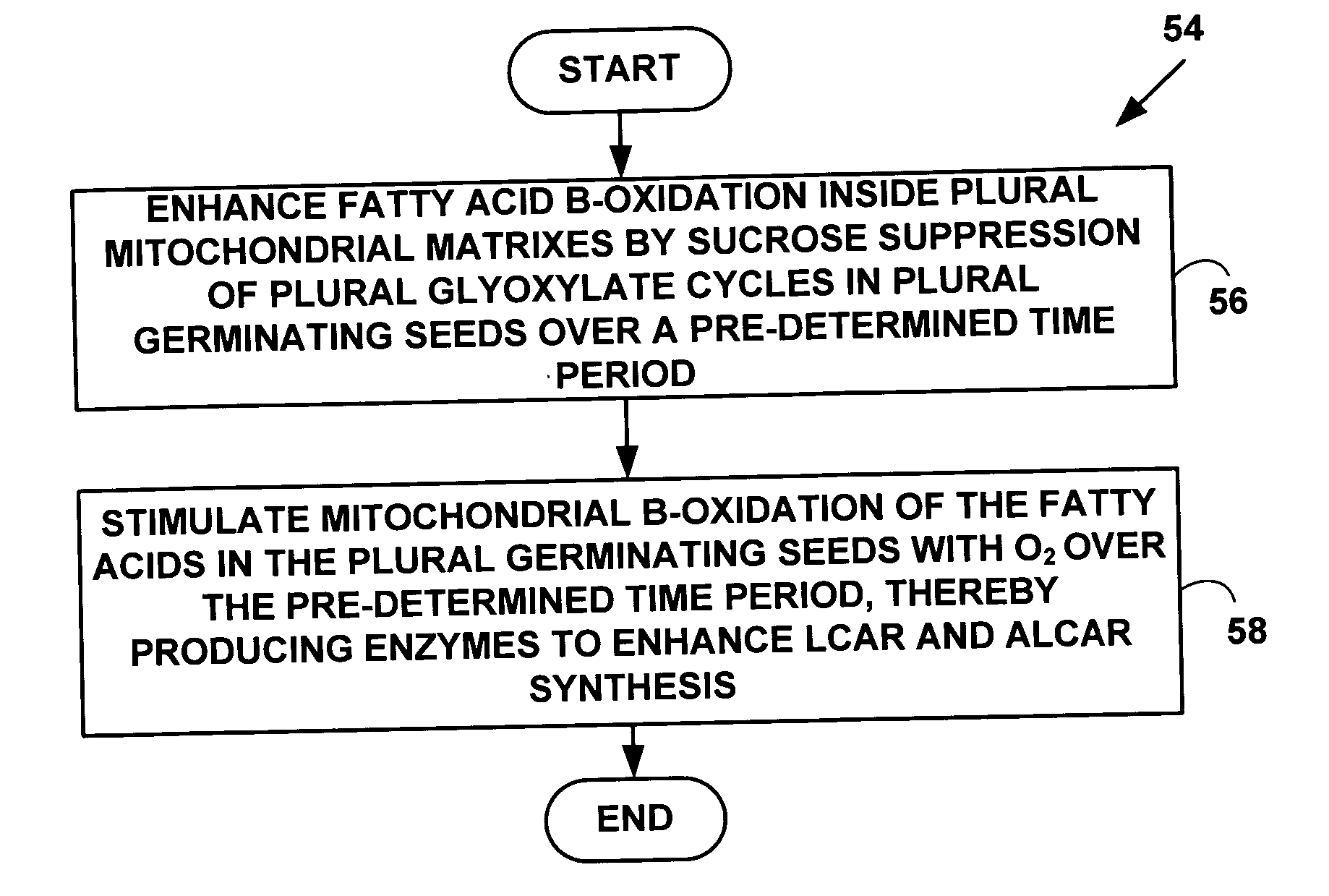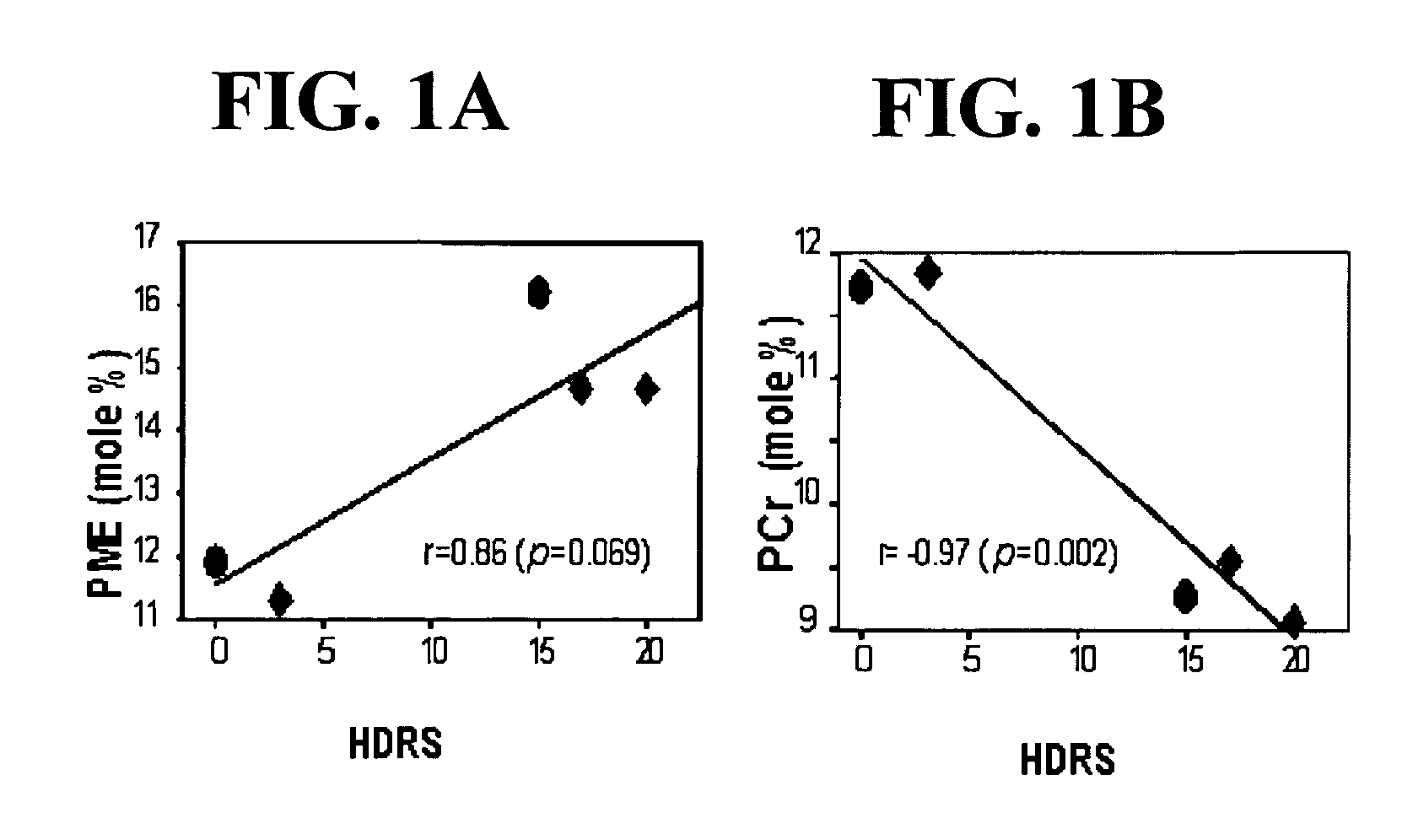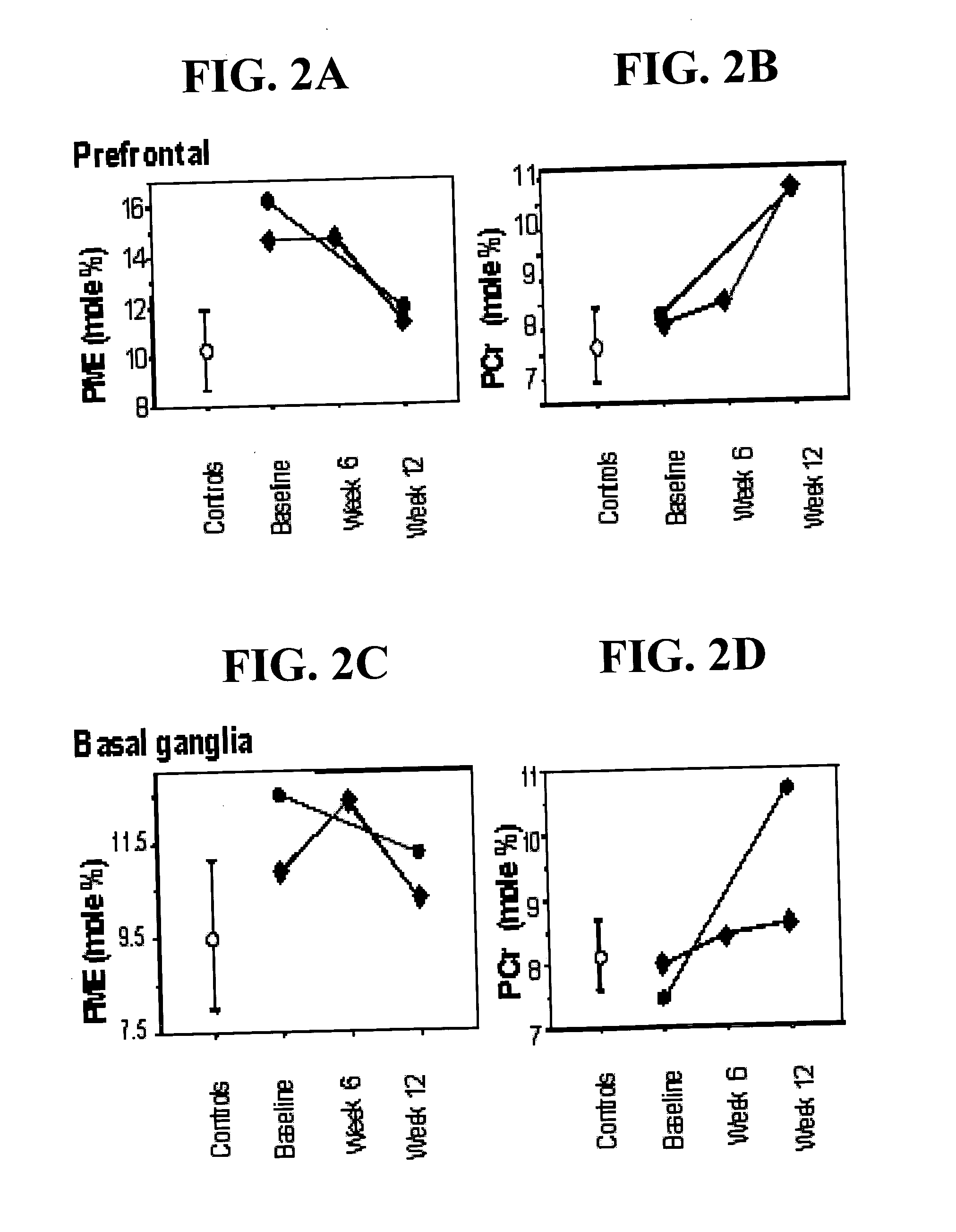[0031] ALCAR has been shown to exert a beneficial effect on brain metabolism after energetic stresses. In a canine model of complete, global cerebral ischemia and reperfusion, ALCAR treated animals exhibited significantly lower neurological deficit scores (p=0.0037) and more normal cerebral cortex lactate / pyruvate ratios than did vehicle-treated control animals (Rosenthal et al., 1992). In a rat cyanide model of acute hypoxia, increased rate of phosphatidic acid formation, possibly reflecting increased phospholipase C activity was observed and spatial navigation performance in a Morris task was impaired. Chronic treatment with ALCAR attenuated the cyanide-induced behavioral deficit but had no effect on energy-dependent phosphoinositide metabolism suggesting ALCAR affected free fatty acid metabolism by increasing the reservoir of activated acyl groups involved in the reacylation of membrane phospholipids (Blokland et al., 1993). In a canine model employing 10 minutes of cardiac arrest followed by restoration of spontaneous circulation for up to 24 hours, ALCAR eliminated the reperfusion elevation of brain protein carbonyl groups which reflect free radical-induced protein oxidation (Liu et al., 1993). In a rat streptozotocin-induced model of brain hypoglycemia, ALCAR attenuated both the streptozotocin-induced impairment in spatial discrimination learning and decrease in hippocampal choline acetyltransferase activity (Prickaerts et al., 1995). A deficiency in ALCAR has been shown to be a cause for altered nerve myo-inositol content, Na+—K+-ATPase activity, and motor conduction velocity in the streptozotocin-diabetic rat (Stevens et al., 1996). Finally, sparse-fur mice have a deficiency of hepatic ornithine transcarbamylase resulting in congenital hyperammonemic with elevated cerebral anmonia and glutamine and reduced cerebral cytochrome oxidase activity and a reduction in cerebral high-energy phosphate levels. ALCAR treatment increased cytochrome oxidase subunit I mRNA, and restored both cytochrome oxidase activity and the levels of high-energy phosphates (Rao et al., 1997). Our studies of hypoxia in Fischer 344 rats demonstrate ALCAR's beneficial effect on brain membrane phospholipid and high-energy phosphate metabolism (Pettegrew et al., unpublished results.
[0032] ALCAR has been shown to effect membrane structure and function in a number of different systems. ALCAR administration affects the inner mitochondrial membrane protein composition in rat cerebellum (Villa et al., 1988), increases human erythrocyte membrane stability possibly by interacting with cytoskeletal proteins (Arduini et al., 1990), increases human erythrocyte cytoskeletal protein-protein interactions (Butterfield & Rangachari, 1993), and alters the membrane dynamics of human erythrocytes in the region of the glycerol backbone of membrane phospholipid bilayers (Arduini et al., 1993).
[0033] A number of studies have demonstrated that ALCAR enhances the neurotrophic activity of nerve growth factor (NGF). ALCAR increases NGF binding in aged rat hippocampus and basal forebrain (Angelucci et al., 1988), increases NGF receptor expression in rat striatum, and increases choline acetyltranferase activity in the same area (De Simone R. et al., 1991), enhances PC12 cells response to NGF (Taglialatela et al., 1991), increases the level of NGF receptor (P75NGFR) mRNA (Taglialatela et al., 1992), increases choline acetyltransferase activity and NGF levels in adult rats following total fimbria-fomix transection (Piovesan et al., 1994; 1995), and enhances motomeuron survival in rat facial nucleus after facial nerve transection (Piovesan et al., 1995).
[0034] ALCAR has some cholinergic activity (Fritz, 1963; Tempesta et al., 1985), possibly because it shares conformational properties with acetylcholine (Sass & Werness, 1973). This is interesting as acetylcholine may play an important role in the chronobiological organization of the human body (Morley & Murrin, 1989; Wee & Turek, 1989), mediating also some effects of light on the circadian clock (Wee & Turek, 1989). Acetylcholine is implicated in the regulation of the hypothalamic-pituitary-adrenal (HPA) axis (Mueller et al., 1977; Risch et al., 1981) and cholinomimetics are effective on the HPA axis (Janowsky et al., 1981; Risch et al., 1981). ALCAR also seems to interfere with the serotonergic system (Tempesta et al., 1982; 1985). There is ample evidence supporting a reduction in serotonergic activity in depression (Ashcroft et al., 1966; Asberg et al., 1976; Cochran et al., 1976; Traskman et al., 1981; Stanley & Mann, 1983); although these results have not always been confirmed (Bowers, 1974; Murphy et al., 1978). The efficacy of 5-HTP also has been reported in involutional depression (Aussilloux et al., 1975). Moreover the selective serotonin reuptake inhibitors (SSRI) antidepressants increase serotonergic transmission and are currently widely used in treating MDD (Aberg-Wistedt et al., 1982; Stark & Hardison, 1985). Serotonin plays an important role in the regulation of circadian rhythms (Kordon et al., 1981; Leibiwitz et al., 1989) and there is consistent evidence that it affects cortisol secretion (Imura et al., 1973; Krieger, 1978; Meltzer et al., 1982).
[0035] ALCAR has been demonstrated to reverse aging-related changes in brain ultrastructure, neurotransmitter systems, membrane receptors, mitochondrial proteins, membrane structure and metabolism, memory, and behavior. ALCAR restores the number of axosomatic and giant bouton vesicles in aged rat hippocampus (Badiali et al., 1987), reduces aging-related lipofuscin accumulation in prefrontal pyramidal neurons and hippocampal CA3 neurons in rats (Kohjimoto et al., 1988; Amenta et al., 1989), and reduces aging-related changes in the rat hippocampal mossy fiber system (Ricci et al., 1989). ALCAR reduces the age-dependent loss of glucocorticoid receptors in rat hippocampus (Ricci et al., 1989), attenuates the age-dependent decrease in NMDA receptors in rat hippocampus (Fiore & Rampello, 1989; Castorina et al., 1993; 1994; Piovesan et al., 1994; and reviewed by Castorina & Ferraris, 1988), and reduces age-related changes in the dopaminergic system of aging mouse brain (Sershen et al., 1991). Age-related changes in mitochondria also are reduced by ALCAR. ALCAR increases cytochrome oxidase activity in rat cerebral cortex, hippocampus, and striatum (Curti et al., 1989), restores to normal reduced transcripts of mitochondrial DNA in rat brain and heart but not liver (Gadaleta et al., 1990), increases cytochrome oxidase activity of synaptic and non-synaptic mitochondria (Villa & Gorini, 1991), reverses age-related reduction in the phosphate carrier and cardiolipin levels in heart mitochondria (Paradies et al., 1992), reverses age-related reduction in cytochrome oxidase and adenine nucleotide transferase activity in rat heart by modifying age-related changes in mitochondrial cardiolipin levels (Paradies et al., 1994; 1995), and reverses age-related alteration in the protein composition of the inner mitochondrial membrane (Villa et al., 1988). ALCAR also increases synaptosomal high-affinity choline uptake in the cerebral cortex of aging rats (Curti et al., 1989; Piovesan et al., 1994), increases choline acetyltransferase activity in aged rat striatum (De Simone R. et al., 1991; Taglialatela et al., 1994), modulates age-related reduction in melatonin synthesis (Esposti et al., 1994), reverses the age-related elevation in free and esterified cholesterol and arachidonic acid (20:4) in rat plasma (Ruggiero et al., 1990), and increases PCr and reduces lactate / pyruvate and sugar phosphate levels in adult and aged rat brain (Aureli et al., 1990). Age-related changes in NGF are reduced by ALCAR: ALCAR increases NGF receptor expression in rat striatum (De Simone R. et al., 1991) and in PC12 cells (Castorina et al., 1993); enhances the effect of NGF in aged dorsal root ganglia neurons (Manfridi et al., 1992); exerts a neurotrophic effect in three month old rats after total fimbria transection (Piovesan et al., 1994); and increases NGF levels in aged rat brain (Taglialatela et al., 1994). ALCAR has been shown in aged rats to modulate synaptic structural dynamics (Bertoni-Freddari et al., 1994) and improve measures of behavior (Angelucci, 1988; Kohjimoto et al., 1988) as well as memory (Barnes et al., 1990; Caprioli et al., 1990; 1995). ALCAR has been reported to normalize the pituitary-adrenocortical hyperactivity in pathological brain aging (Nappi et al., 1988; Ghirardi et al., 1994). We have reported that ALCAR improves standardized clinical measures and measures of membrane phospholipid and high-energy phosphate metabolism in subjects with Alzheimer's disease (AD) measured by in vivo 31P MRS (Pettegrew et al., 1995). We now have data in a rat hypoxia model which demonstrate that ALCAR has more beneficial effects on aged rats (30 months) than on adolescent (1 month) or adult (12 months) animals (Pettegrew et al., unpublished results).
[0036] In European clinical trials, ALCAR has been shown to have significant antidepressant activity in geriatric depressed subjects with minimal or no side effects (Villardita et al., 1983; Tempesta et al., 1987; Nasca et al., 1989; Bella et al., 1990; Fulgente et al., 1990; Garzya et al., 1990; Gecele et al., 1991). Villardita et al. (1983) reported a double-blind ALCAR / placebo study of 28 subjects (18 males, 10 females; 72.3∀7.3 years). Sixteen subjects were treated with ALCAR (1.5 gm / day; baseline HDRS=26.3∀3.3) and 12 Patients were treated with placebo (baseline HDRS=26.6∀3.2) for 40 days. By day 40, the ALCAR treated subjects showed significant improvement (p<0.001) in the Hamilton Depressive Rating Scale (HDRS) but the placebo treated subjects did not. There were no side effects to ALCAR. Tempesta et al. (1987) in an open label, cross over study of 24 subjects over the age of 70 years, all of whom were nursing home residents, reported ALCAR (2 gm / day) to be highly effective in reducing HDRS scores, especially in subjects with more severe clinical symptoms. Again there were no reported ALCAR side effects. In a simple blind ALCAR / placebo study of 20 subjects (10 ALCAR treated subjects; 62.5∀5.7 years, 8 males, 2 females, baseline HDRS=44.9∀3.1 and 10 placebo treated subjects; 62.5∀5.3 years, 8 males, 2 females, baseline HDRS=43.9∀2.8), Nasca et al. (1989) demonstrated a significant improvement in the HDRS scores of ALCAR treated subjects at day 40 of treatment (p<0.001). There was no improvement in the placebo treated group. Similar significant beneficial effects of ALCAR on the HDRS were observed in randomized, double-blind, ALCAR / placebo studies of Garzya et al. (1990) (28 subjects; ages 70-80 years; ALCAR 1.5 gm / day), Fulgente et al. (1990) [60 subjects; 70-80 years; ALCAR 3.0 gm / day; baseline HDRS (ALCAR=25; placebo=23); day 60 HDRS (ALCAR=12; placebo=22); p # 0.0001], and Bella et al. (1990) [60 subjects, 60-80 years, ALCAR 3.0 gm / day; baseline HDRS (ALCAR=22; placebo=21); day 60 HDRS (ALCAR=11; placebo=20); p # 0.0001]. ALCAR was well tolerated in these studies even at the higher dosages. A double-blind, ALCAR / placebo study by Gecele et al. (1991) (30 subjects, 66-79 years, ALCAR 2 gm / day) not only showed a significant improvement in the HDRS of ALCAR treated subjects (p<0.001) but a significant reduction in both mean cortisol levels (p<0.001) as well as 12 am (p<0.001) and 4 pm (p<0.01) cortisol levels.
 Login to View More
Login to View More  Login to View More
Login to View More 


